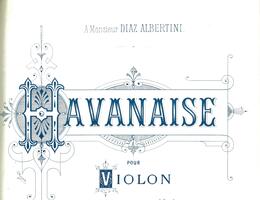Havanaise in E major op. 83
Camille Saint-Saëns composed his Havanaise op. 83 in 1887. Originally written for violin and piano, the work was published the following year in Paris. Legend has it that the composer was inspired by the sound of the fire crackling in the hearth of his hotel room in Brest whilst on tour with the Cuban violinist, Raphael Diaz Albertini, the work’s dedicatee. Saint-Saëns was keenly interested in ancient music, as well as Greek and Egyptian modes and extra-European music, and he no doubt talked at length with the violinist about Hispanic and Latin American rhythms, so the Havanaise was a product of that friendship. The havanaise, or habanera, a dance with a syncopated, binary rhythm and a strong first beat, appeared in Cuba in the early part of the 19th century. Here, it is freely developed in rondo form, almost entirely for the enjoyment of the rhythm. Built on two duple tempi, the entire piece, which lasts about ten minutes, is pervaded by its characteristic rhythmic pattern of a quaver triplet followed by two quavers. A dreamy, lyrical melody on the violin serves as a more peaceful refrain between highly virtuosic episodes. The Havanaise was first performed on 7 January 1894, at the Concerts du Châtelet, with the Belgian violinist, Martin-Pierre Marsick (1847-1924), as soloist. It immediately claimed its place among the great contemporary standards for violin, alongside the Poème by Ernest Chausson (1896), the Symphonie espagnole by Édouard Lalo (1874) or, indeed, the Introduction et Rondo capriccioso by Saint-Saëns (1868).

